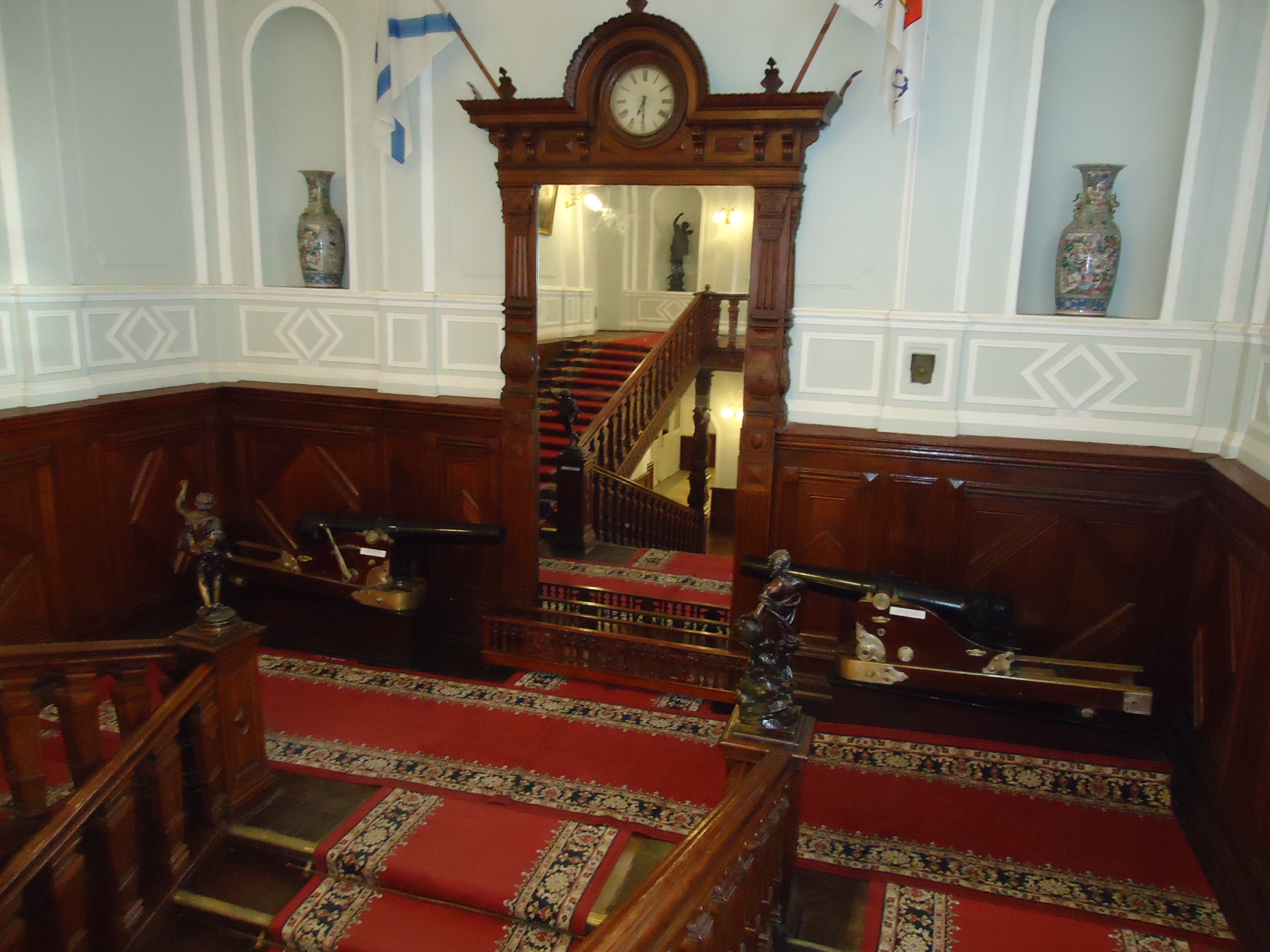Description of Kronstadt (especially ships and docks) made by Fred. T. Jane in the late 19th century.
I guess it would be interesting to know how the Englishman considered a life in Kronstadt dock yard. If you've already been here a description will surprise you with their uniqueness. But we have to understand that in the end of the 19th century there were no those architectural landmarks, which were appeared in the early 20th century (the Naval Cathedral and others). Moreover, as is clear from the description, the author did not have much time to see everything. His attention was attracted by the docks and institutions of the Navy. However, this is not a great drawback. Kronstadt was then the military town and hardly anything else could attract a specialist in the Navy. From my side I added photos of ships and buildings, of which the author writes. Place the cursor on the photo to clarify what is it.
General history of the Pre-Revolutionary Russian Navy. THE IMPERIAL RUSSIAN NAVY. ITS PAST, PRESENT, AND FUTURE by FRED. T. JANE (More than 25 Mb !!! in PDF ).
Roman.
Kronstadt was founded in the days of Peter the Great, and some of his buildings are still to l)e found there alongside modern shops. A few years since many of them were in a more or less tumbledown condition, but that is mostly all changed now—the hands of the repairer have been busy.
Kronstadt Dockyard is a fitting and repairing one. Xo ships are built here ; the place is essentially a naval station. The Russian system is to decentralize—to specialize, as it were, with different yards ; there is, for example, no equivalent to Portsmouth or Toulon to be found in Russia. The system has its weak points; it has, however, its strong points also, in the resulting simplicity.
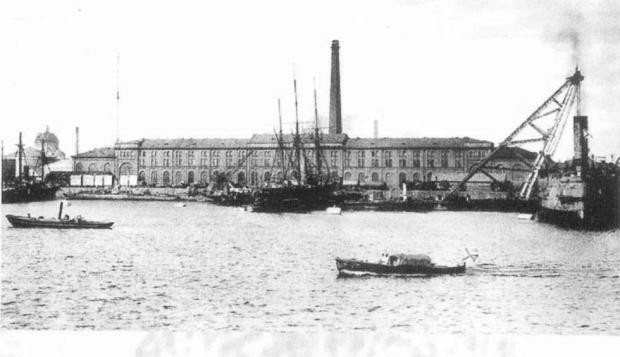
The entire area of the dockyard is about one million square yards, but the whole of this space is not full. In the arctic conditions prevailing at the time of my visit it was not very easy to tell what was land and what was sea ; the ubiquitous snowdrifts covered everything, and perhaps made the place look larger than it really is.
Docks. There are at Kronstadt four large dry docks—the Alexander, 584 ft. by 85 ft. by 29 ft.; the Constantine, 490 ft. by 73 ft. by 29 ft. ; the Nikolai and the Peter, somewhat smaller, but big enough to take most ships. The Alexander is a very capacious dock indeed, and at the time of my visit it contained the new battleship Sevastopol, the destroyer Sokol, and a torpedo gunboat of the Posadnik type. The Sokol, a Yarrow destroyer, has already been described and illustrated. It suffices here, therefore, to mention that she is a 240-ton boat, and on trial with 4490 horse-power made 30 "28 knots. She is 190 ft. long by 18 ft. beam, carries 60 tons of coal, and is fitted, of course, with Yarrow boilers—eight of these. Those who saw this celebrated little ship in England would find difficulty in recognizing her at Kronstadt, wooden sheds on her deck, icicles and snowdrifts over all ; but, of course, this was only the winter coat. I noticed that she was painted a peculiar dirty brown-grey color, a little lighter than that which the British Navy adopted for the earliest destroyers.
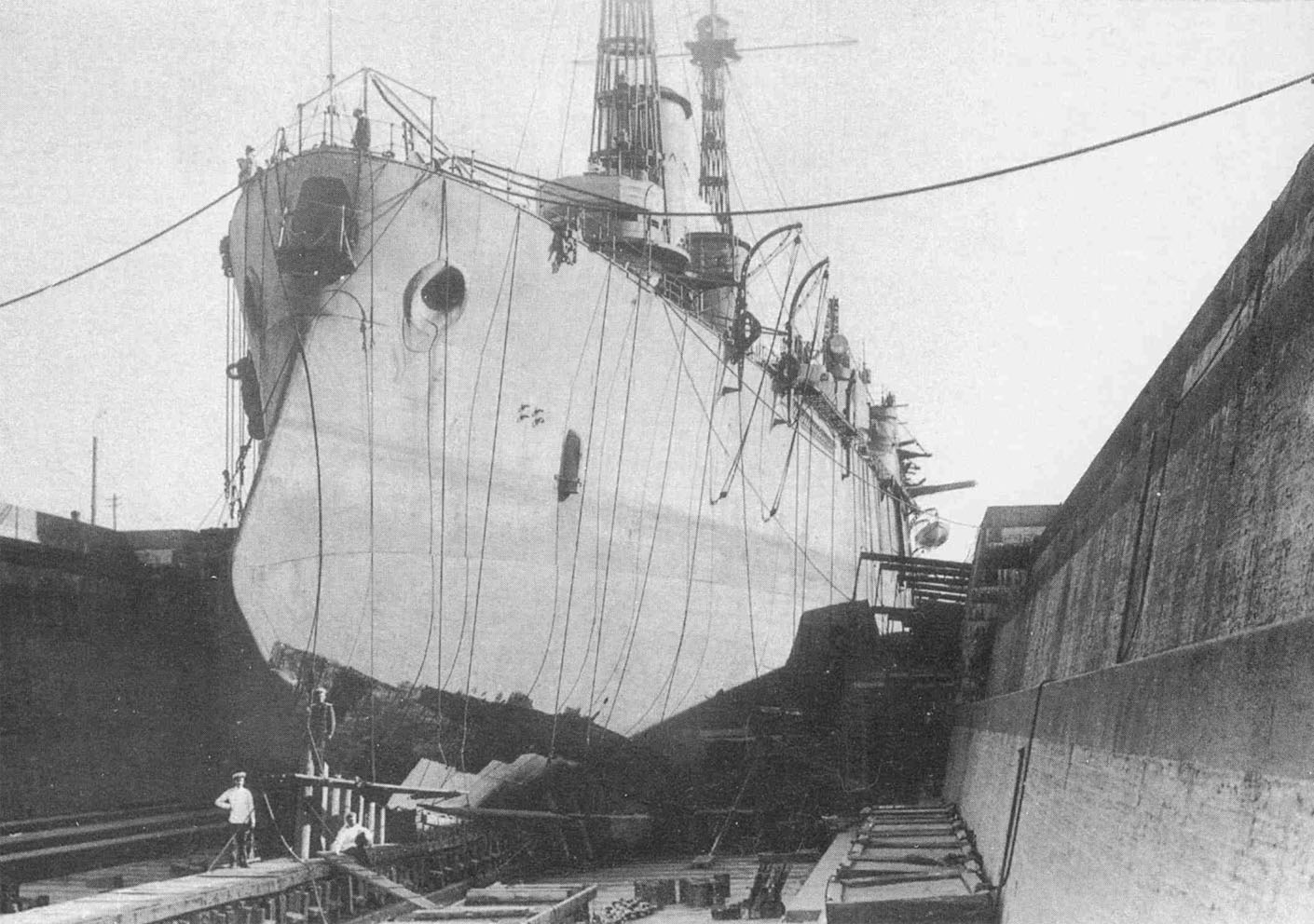
The Posadnik was "made in Germanv," being an Elbing craft, launched in 1892. She is of 400 tons, the same length as the Sokol, but over 24 ft. beam. Her draught is 11 ft. The finer lines of the destroyer alongside made her look a rather clumsy craft. The Posadnik's armament is six 3-pounders, three 1 -ponders, one torpedo tube in the bow, and one training- tube abaft the funnel. There are two masts.
The horse-power with forced draught is about 3500, and the trial speed about 22 knots. She has a couple of locomotive boilers, and carries 90 tons of coal.
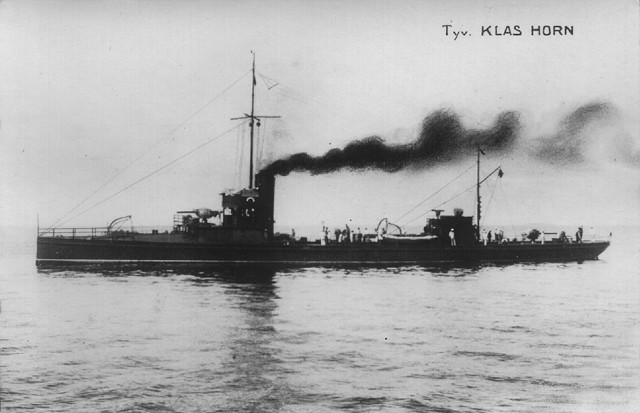
I was told that on trial last summer the Russians got 30 knots out of the Sokol, and they seemed
exceedingly pleased with her altogether. Copies of the Sokol are being built ; altogether twenty-eight are either building or projected. As to the number in hand there is considerable doubt. Two were launched at St. Petersburg, at a torpedo yard up the Neva, last year, and two others were set afloat by a private firm at Abo. Of the remaining twenty-four, perhaps a dozen are at present in hand. Messrs. Laird of Birkenhead have a destroyer in hand of the 30-knot type — the Som. Some of the twenty four will probably be copies of this craft.
There is some indecision in Russia at the present moment as to whether it is better to have destroyers or submarine boats. The Russians have a special type of submarine boat—semi submarine would be a better word, as the boat is only intended to sink at the moment of attack. Fifty of these are projected, but nothing is likely to be done till the result of the Tsar's Rescript is ascertained.- So far as I could make out, this type of boat is a submarine ram as much as, or more than, a torpedo boat. It is larger than the French craft. However, since it is as yet inbuilt and untried, it is too early to discuss its pros and cons, and I am, perhaps, exceeding my limits by saying much about it. I may, however, mention that the Russians believe very much in underwater craft, and do not regard the submarine battleship as an idle dream.
To leave the battleship in nubibus for the battleship de facto. Kronstadt contained specimens of the latest. At the time of my visit the Peresvet, Sevastopol, Poltava, and Seniavin were all in dock or basin. The Peter Veliky, Nikolai i., Khrabri, Minin, Svietlana, Edinbouriski, Rynda, and a number of monitors and old craft were also about.
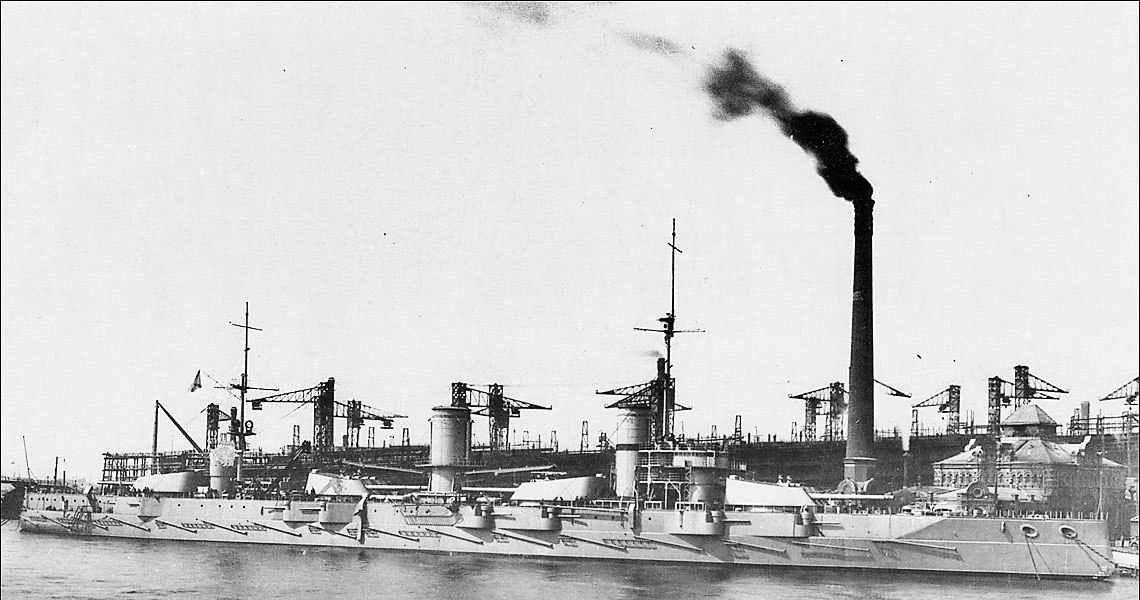
After inspecting the Sevastopol I had a look at the Admiral Nahimoff in the next dry dock close by. This ship, an armored cruiser of about 8500 tons, formerly carried eight 8 -in. and ten 6-in. guns,—a truly mighty armament. All these guns are gone now and at the time of my visit she was stripped bare, even the gun-houses in which the barbette guns used to be carried being removed. She is to be rearmed, re-boilered, and generally modernised, and will probably not be about for some time to come—not for a year at least, possibly longer. The new armament will probably consist entirely of 6-in. quiekfirers.
The weak point of this ship is her feeble protection, identical in arrangement with that of the French Magenta type. There is an all-round compound belt, 10 in. thick at its maximum, but it i a very small strip. The barbettes, again, are merely strips.
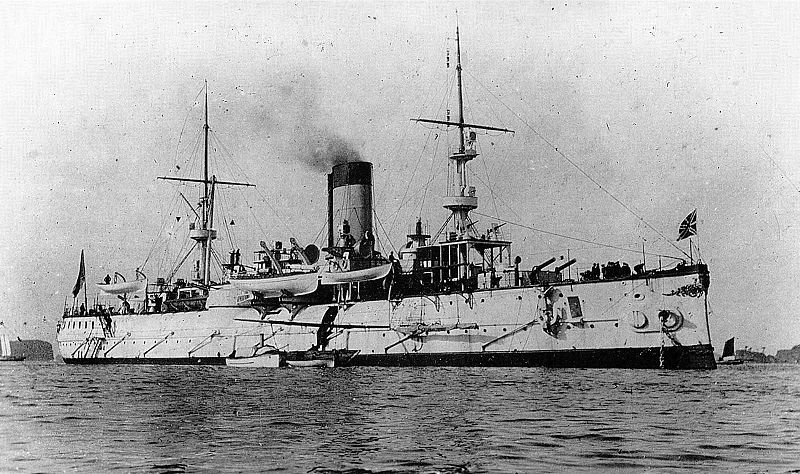
Apropos of this ship, a few days after seeing her in tuis dismantled condition 1 read m one 01 our principal evening newspapers, which has something of a reputation for its naval intelligence, that : " We learn from an unimpeachable source that . the Admiral Nachimof, now in the Mediterranean, will shortly go to Russia to refit, and thence to the Far East."
It is an interesting instance of how loosely statements as to the Russian Navy are made.
Beyond the two dry docks mentioned above is a very large basin of irregular shape. Its exact form I could not make out, the snowdrifts blotted out all configuration. In the same way it was not possible to tell how much of what looked like a long, rather narrow basin was basin, and how much " stream " -with a jetty projecting into it—absolutely nothing, save a few elevated narrow pathways, and a glimpse of wall here and there, told what was "water" and what was land. In these basins lay the ^ Peter Veliky, Minine, Nikolai, Rynda, a number of old turret-ships, and the modern ironclads Peresveet, Seniavin, and Poltava.
The Peter Veliky is destined to be reconstructed, Harvey or Krupp process turrets replacing the present one, and modern 10-in. guns in place of the old 12-in.
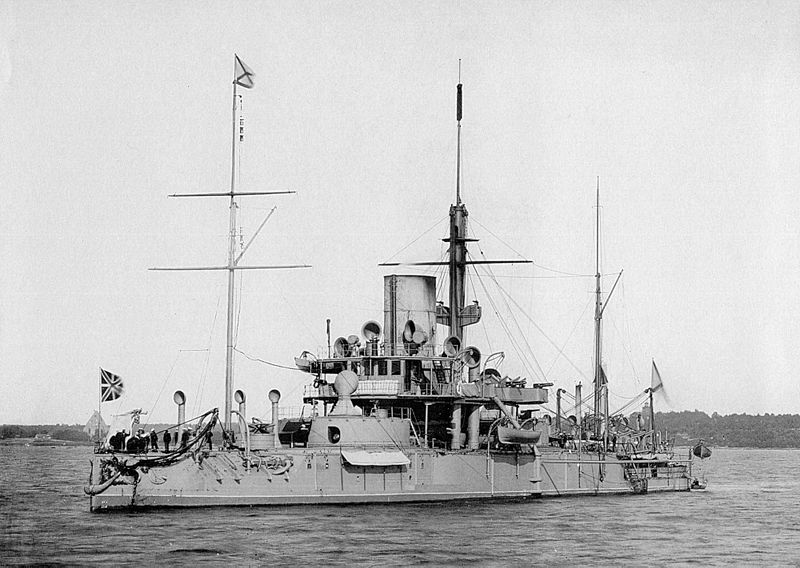
The Nikolai i. is perhaps the best-known ship in the Russian Navy. The only thing that particularly struck me about her was, how very unlike she is to most of the photographs of her that one encounters : the masts looked much loftier than photographs render them, and the ship altogether less clumsy.
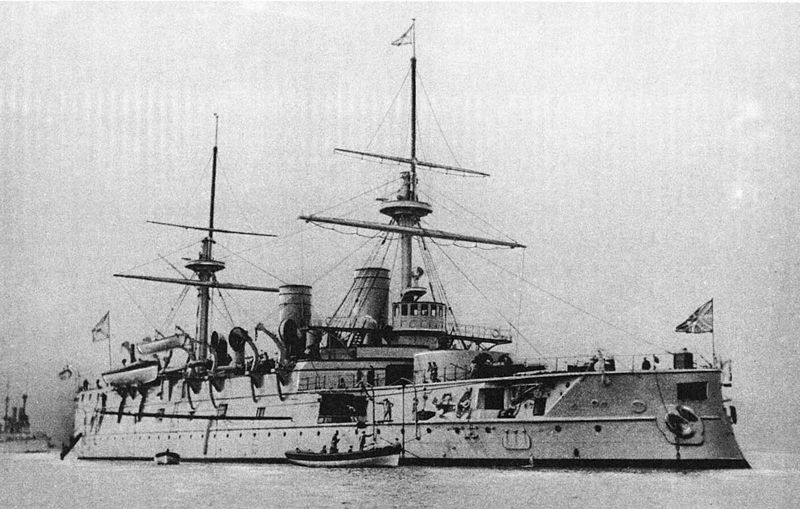
The old Minine is, and has for a long time been, under reconstruction, but progress on her was at a standstill. She will eventually be brought forward as a seagoing training-ship ; at present she is merely a hulk, with only the fore and main lower masts standing the mizzen being altotretlier removed.
The Rynda is an old vessel of very small fighting value. She was nearly as much dismantled as the Minine.
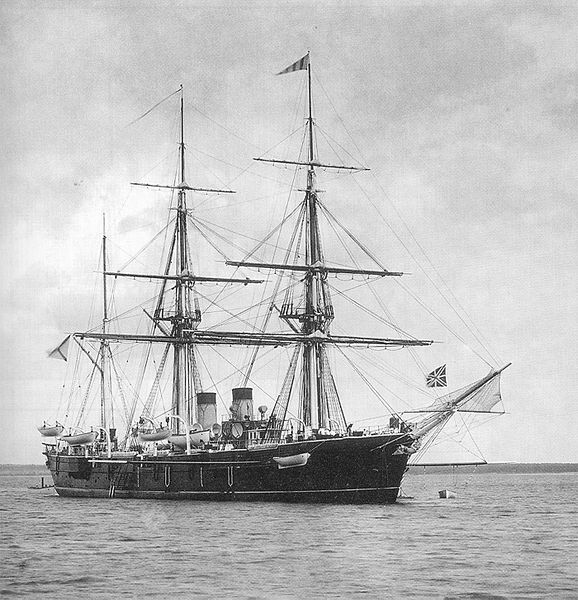
The Svetlana next claimed attention. She was in the ice. lying- well out in a large basin, but boards were laid to her over the snow that covered the frozen water, so that with a little cautiousness she was easy enough to get at. Some care was indeed needed, as the snow was pretty deep, and the boards, of course, slippery. Alongside the ship a large square hole was cut in the ice. From this hole water for washing purposes was drawn. So far as the ship being ice-bound was concerned, this hole had no significance; the pressure of the ice has apparenth^ no inconvenient effect upon the hulls. I did not anywhere notice any of those elaborate precautions which being frozen in is popularly supposed to necessitate. The hole in the ice had one other use—the Russian sailors used it for bathing I The Russian bluejacket is a hardy fellow, and a few degrees of frost add zest to his ablutions. He does not, perhaps, wash very often,—" He ain't clean enough for it to be nice to get along side and chum with him,"is the British bluejacket's reason for the absence of that entente cordiele between Jack and Ivan that exists between his officers and Russian officers,—but when Ivan does wash, twenty or thirty degrees of frost will not stop his enjoying a swim. When they make a hole in the Neva, and bless the water in front of the Tsar and the Court in the New Year festivities at St.Petersburg, plenty of moujiks jump in and seek salvation and cleanliness in the sacred waters. A Japanese naval officer once gave me his first impression of Russian sailors as he had seen them in some northern Japanese harbor, and the thing that most impressed him was Russian sailors bathing in an ice-covered sea.
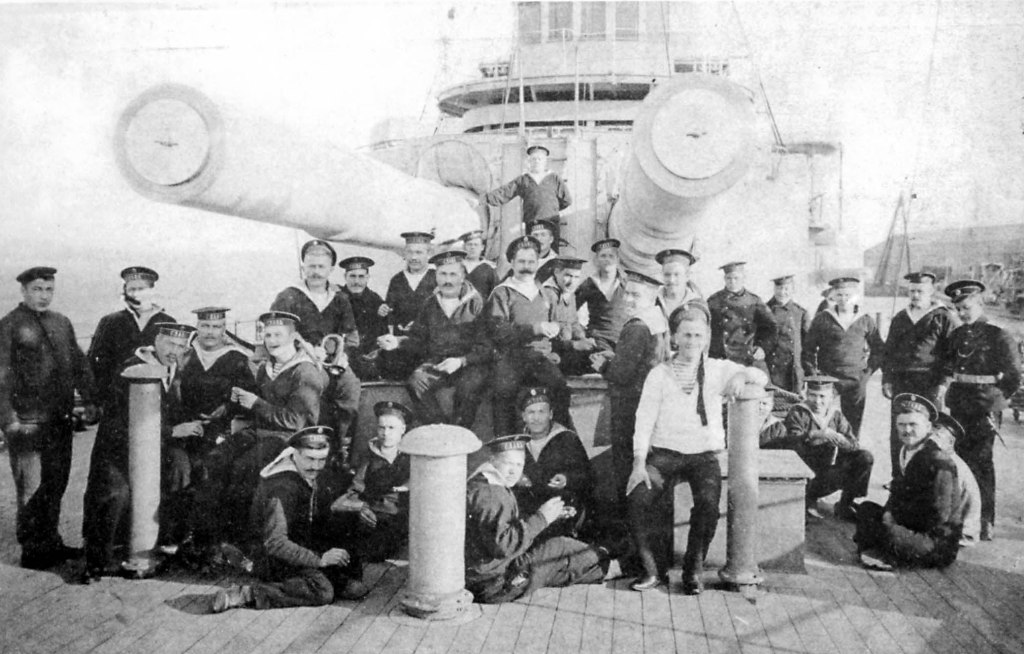
As a rule, Russian ships are almost, if not quite, deserted for the winter, but the Svietlana was hibernating with most of her officers and men on board. To the smart cruiser that was to be seen at Havre some while ago she bore very little resemblance. The whole of the deck amidships was roofed in with wood, much as the decks of our hulks used as depots are roofed in. Little wooden sheds were built over the fore and aft guns, around the chart-house, and over the searchlights on the masts. But for her three funnels and enormous ram she would have stood very well for a frozen-in whaler as we see them in picture-books.
The Seniavin was built-in in much the same fashion. She and the Poltava have been already so fully described that nothing remains to be said about them here. The Peresvet, too, admits of little but a passing reference. Men were at work on board her, and save for her masts (a couple of temporary poles) she looked fairly complete. She was being pushed forward to relieve some vessel upon the Pacific station—the Rurik probably.
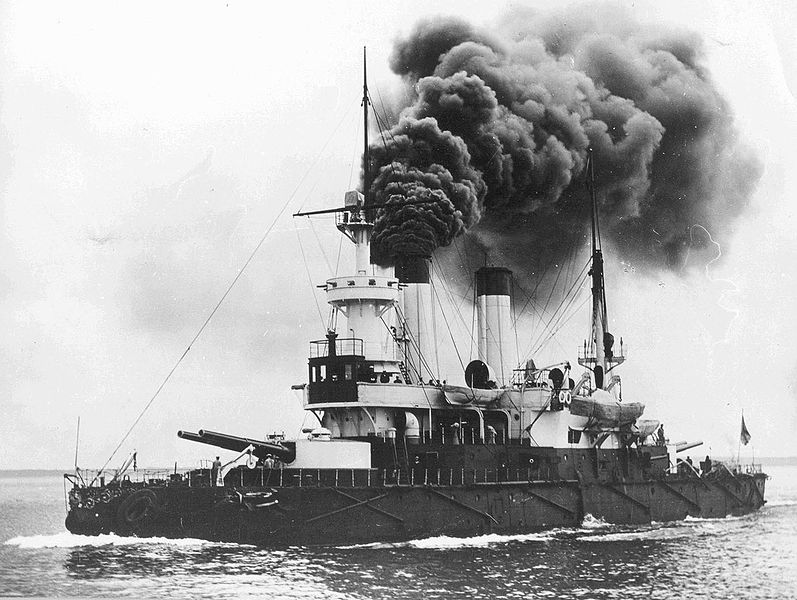
In the dlescription of the Peresvet some reference should have been made to her construction. The Russians are exceedingly proud of the fact that "everything, down to the smallest rivet, was made inRussia." Whether or no materiel has suffered for the benefit of patriotism time alone can show ; since the loss of the Gangut an impression has been abroad that home-made construction in Russia is necessarily very bad. The Gangut, it may be remembered, was lost in 1897, and her loss, rightly or wrongly, was attributed to bad construction. Officially, I believe, she was said to have struck a rock in a part of sea where no rocks exist—so at least the story goes. Bad Russian ship construction is no new thing. A hundred years ago Orloff's fleet, going to the Mediterranean, had to put in at Portsmouth for repairs, some of the vessels only keeping together by cables.
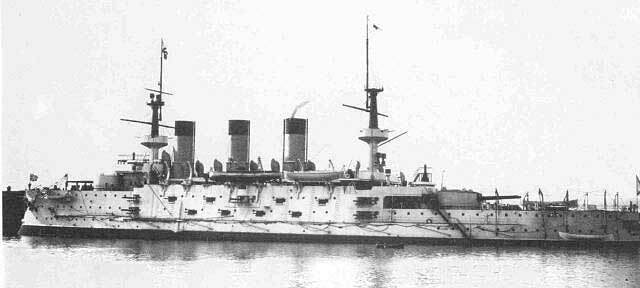
The cause then was that the ships were built of for construction of Russian and very badly suited for ship construction. Some of this reputation has stuck to the Russians ever since. On the whole, facts—so far as I can judge—do not seem to point to any general bad construction of hulls in the Russian fleet, the Peter Veliky, which had to undergo something very like a reconstruction at Glasgow, and the Rossia, which split her decks up from the strain of filing her enormous armament, being the only two specific instances that can be cited. Stories were afloat once about the Nahimoff, but it subsequently turned out that the origin of these tales lay in the ship having gone on trials before her forecastle was built in. The Ekaterina 11 in the Black Sea Fleet, was muddled over to a certain extent, as her armour has no backing, but that was due common to clerical error. Every navy has a few ' black-sheep " inmies ships ; even our own is not exempt. The Penelope, Supert, Neptune, Ajax, and, to some ext-ent, Nile and Trafalgar, are ships which for one cause and another — " tinkering " sometimes—may be said to have a black mark against them. The Texas in the United States Navy, the Brennus and Magenta in the French, the Oldenburg in the German, the K. E. Stephanie in the Austro-Hungarian Fleet, are merely a few of the better-known instances of ships that have not fulfilled expectations. At the worst the Russian Navy does no more than come near the top of the list ; at the best it is not at the bottom. But here one trenches on the unwritten and secret history of modern warships. Even in batches of new ships there is, for one reason or another, usually a "bad egg," and to conceal the fact is naturally a thing to which energies are directed. Even in England there are instances in which this is successfully done. We may take it as a sure thing that it is done to as great —probably much greater—an extent in foreign navies.
To resume the description of Kronstadt. The next ship I directed attention to was the Khrabiy. But since she was cut oft' by snowdrifts, and also housed in with wood, I failed to derive awx very clear impression of her details, beyond discernino- that she bore a very small relation to the usual description of her.
This concluded my tour of Kronstadt Dockyard, so far as ships were concerned. Such of the workshops as I saw were of enormous size, particularly that in which all the hammocks, etc., for the fleet are made. These are—so I gathered—entirely, or almost entirely, made by hand labour. For this several hundred women and girls are employed, and there were two tremeudoirs long rows of them sitting opposite each other on forms, laughing- and chattering as they worked.
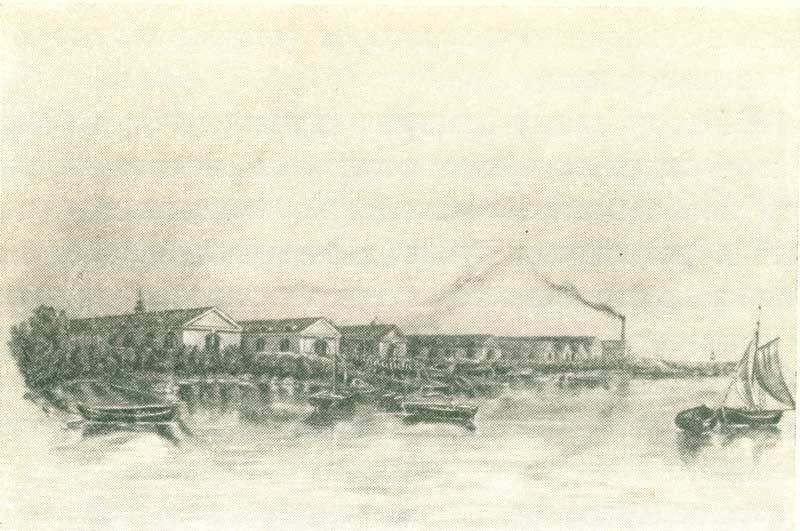
Another item I noticed in the lower part of this building was a row of bow scroll-works for men-of-war. Some of these belong to old vessels now broken up, and hang there waiting for new ships of the same name to bear them. There may be more in this than a mere sentimental idea ; at least, if the idea of teaching crews the history of a ship's name has any value, this treating the figurehead or its modern equivalent in the light of a regimental colour should be distinctly useful. In the British Navy we have had for some years a custom of painting up in a battleship the names of actions in which earlier vessels bearing that name have taken part ; the idea of preserving and passing on the figurehead is distinctly a Russian novelty. We could hardly copy it, as not only are our new vessels devoid of figureheads, but they are disappearing from the older ships. The Rodney once had a real figurehead, but it is now gone, and when the Royal Sovereign—one of the last ships to have a bow scroll—got her gilt scroll-work knocked off, it was not replaced. The figurehead has never — pace the stories, yarns, and anecdotes written in the period when figureheads had a reign—-been much of a British institution. Fashion brought it in now and again in the old days, but it was several times ordered to be discontinued.
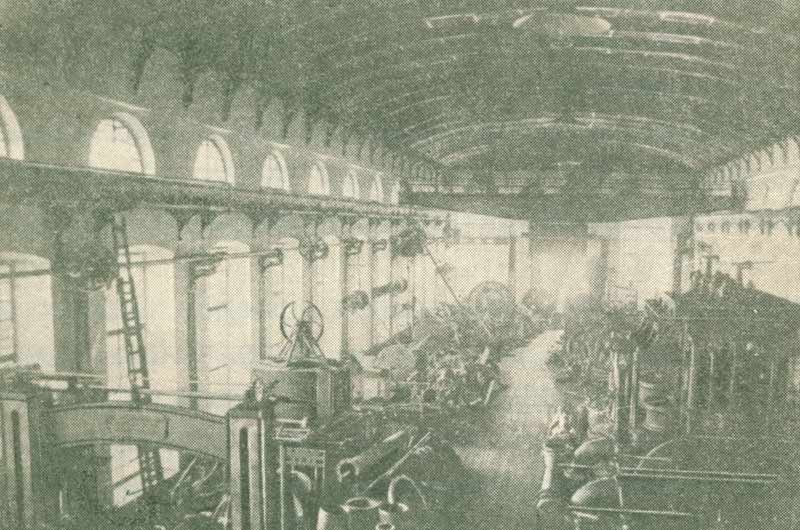
A feature of nearly all the buildings in Kronstadt Dockyard is the stone spiral staircase—architecturally known as a newel — by which the upper stories are reached. These staircases are relics of Peter the Great's first buildings.
Kronstadt Dockyard is popularly supposed to be about as accessible to the world at large as Thibet. I doubt whether it is really so strictly preserved as that. True, it is not open to the ordinary casual tourist, but then Kronstadt is not a place that the tourist would seek. It is situated on an island well out in the gulf, to be reached only by steamer in the summer, in the winter by a four or five mile sledge-drive over the frozen sea from Oranienbaum. "Diligences" also labour over this ice road, but there are a variety of reasons for preferring an open sledge.
The thermometer in the winter may stand anywhere between freezing-point and thirty degrees of
frost—degrees Centigrade, I believe; and there is always a wind over the gulf which creates a blizzard with the dust of frozen snow. None the less, there is a good deal of trafiic to the place every morning, and the people, only a fraction of whom are naval or military, come into and go from the town as easily as even they might come or go into Portsmouth or Devonport.
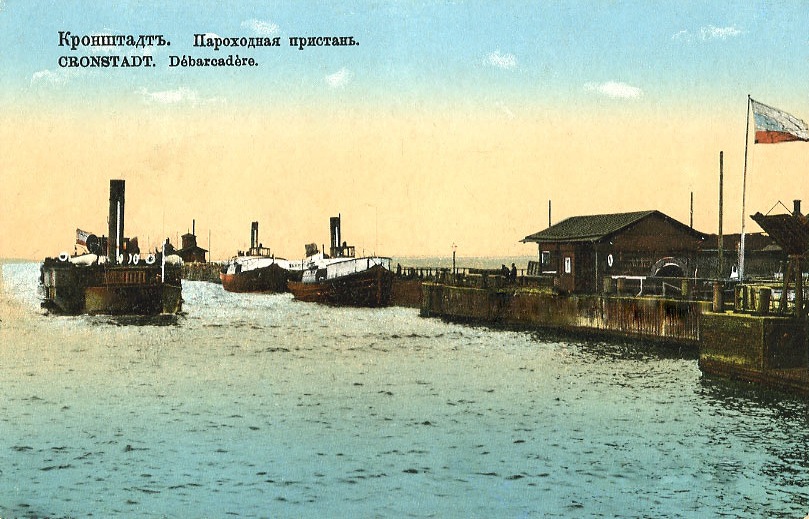
The yard is enclosed by a low wall—in places a outside the dockyard, mere palisade—in which are frequent doors guarded by police, who apparently have orders to detach a man to follow whoever enters. My cicerone here as elsewhere was a naval lieutenant, but when we went into the yard a policeman plodded silently along in the snow beyind us. All this serves to give the place an air of mystery, but I still think it is much of it more apparent than real. None the less, I must confess, —such are the ideas of Russia that we imbibe almost with our mother's milk and cultivate afterwards with courses of sensational literature,—I must confess that I could not view that plodding policeman with equanimity. The most ridiculous tales of unfortunate a policeman iin Kronstadt Englishmen suddenly seized and transported to quick-silver mines in Siberia suddenly came into my head, and assumed a most painful realism and probability, especially when I was led into an absolutely empty and deserted corner of the dockyard between some snowdrifts.
I learnt in due course that we had gone into this cul-de-sac because from thence a view of the
Sevastspol and Poltava more or less in line with each other could be seen ; while the stolid stare and twitching hand of the policeman, I gleaned, meant nothing worse than that a rouble for his trouble would be cheerfully accepted and expended in liquid good wishes to the Ingliski. Verily our Russian literature has a good deal to answer for ! However, this sort of thing is neither history nor a description of Kronstadt Dockyard.
The dockyard, as already stated, lies very low, and a fair amount of it can be seen from the roads and streets outside, or, at anyrate, could be seen pretty well with a glass. Possibly, seeing that to use a camera or sketch in the streets of even St. Petersburg without permission renders a man liable to be "run in," to attempt to view Kronstadt from the outside might lead to unpleasant enough consequences ; still, some sort of viewing could be done.
The Elswick ice-breaker Ermak will make a vast difference to Kronstadt in future winters, as she will keep the channel and fairway open all the year round. At the time of my visit she had not arrived, but she was almost daily- expected, and the interest aroused was very keen indeed—her importance was beyond that of a first-class battleship.
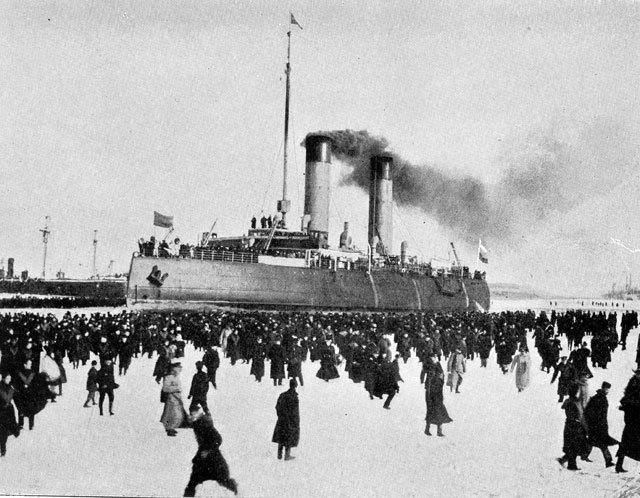
From the dockyard I went across to the gunnery school, a species of "Whale Island'' standing behind the dockyard. The way to it lies alongside an enormous excavation, empty then, into which all the water in the docks and basins can be turned. It is possibly connected with some system of drainage for the low-lying and marshy land upon which the dockyard is built. Its dimensions I could not very well gauge, as from the pathway the bottom was not properly visible. One side was a perpendicular wall, that looked about 100 feet deep ; the .side opposite to that upon which I stood rose in a series of steps, as though excavations would be continued in the summer. My first impression of this sort of embryo replica of a Martian canal was that it was a sandpit or quarry of some kind, but this I heard was incorrect. I gathered that it is regarded as somewhat of an engineering feat, and that its making; demanded the overcoming of a good many initial difficulties.
The gunnery school dates more or less from Peter the Great's day. In architecture it is rather after the style of an old cathedral cloister ; and the modern guns peeping between the ancient arches in a kind of crypt, the glass doors and pitch-pine partitions under a vaulted stone roof, give a most incongruous and quaint tout ensemble.
The class-rooms and artillery museum are upstairs, reached by the usual old-time spiral steps. The museum is very complete ; it contains every type of small quickfirer, the breech-pieces and mechanism of a variety of Canet and Krupp 6-in guns, revolvers and rifles from the earliest times, chronologically arranged. One case contains" rifle bullets, and includes the celebrated Dum-Dum. . All the well-known bullets for various rifles are here, as well as a number of others
placed by themselves, which I could not name. Some of these were of eccentric shape, probably experimental and theoretically-invented bullets. This museum contains a specimen of the earliest explosive bullet, invented back in the days of smooth-bore muzzle-loaders. Russia bought up the secret of this bullet, and then put it in a museum, making no use of it, except possibly towards
the close of the Crimean War.
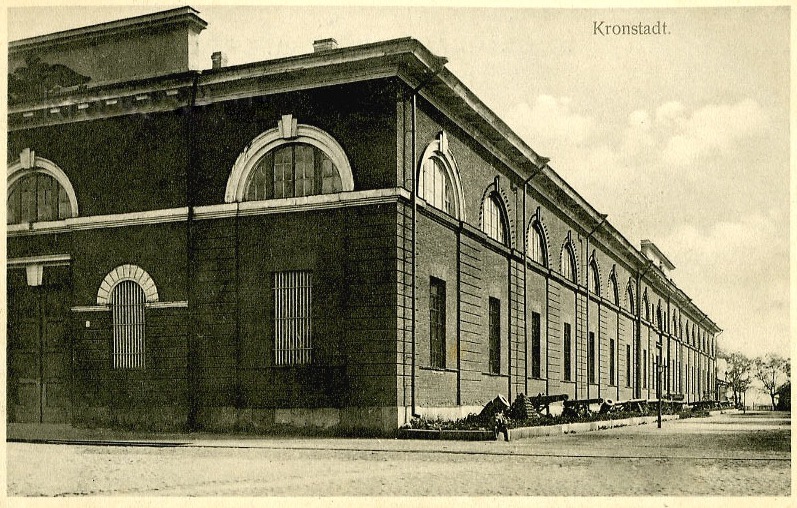
Round about this room shell are standing, from 12-in downwards. Mostly these were common shell of the usual pattern, with flat noses for the fuse to be screwed in. There were a few armour-piercing shot, — now abolished in the Russian service,—or they may have been A. P. shell with base fuses. I did not have shown me any of the famous " magnetic " shell or the capped projectile, but these are now served out for all big guns, and have the same penetration as A. P. shot. As noted above, the A. P. shot is abolished. The H.E. shell is not yet in the Russian service.
The " magnetic " shell,so far as I can gather, was rhe there, and is apparently a short conical shell with shell another cone fitting on top of it. At least, I saw projectiles which, so far as my limited knowledge of gunnery would carry me, looked to be designed for some such use. In whatever form employed, the shell has no particular advantage over the solid shot, as the shot aoainst thick armour will do all the damao;e needful in such places, and there is always the risk of the shell breaking up, no matter what its head. In theory, perhaps, the "magnetic" shell is intended to penetrate armour partially only, and then to shatter by bursting, but that sort of thing is apt to remain theory.
Class-rooms. The class-rooms consist of gunnery lecture-rooms, in one of which officers, and in another men, were attending lectures ; two rooms for electrical plant and instructions, a large and well-fitted laboratory, a room apparently devoted to hydraulic gear, a room with miscellaneous fittings, and a sort of large central hall. This hall, which looked as architecturally interesting as the Tower of London, has its deep recesses filled with photographs and other details of various Russian battleships. At one end there is a large working turret, armour and all. In place of the guns, however, a couple of tube cannon are fitted, and on the turret roof a Barr and Stroud range-finder.
At the other end of the hall is a very large painted background of sea and sky, with some movable dummy ships. In this arrangement there is, of course, nothing novel so far as the taroO-et is concerned. Where the novelty comes in, is in the carefully-painted target producing as nearly as possible the actual sea colours,— a by no means unimportant thing when we remember
that the usual Morris tube tare-et is black against white or vice versa,—and the elaborate revolving turret by means of which the guns have to be re-laid each time, more or less as they would have to be re-laid in actual practice. There is also a war game room, but as Kriegspiel
belongs rather to strategy and tactics, its chief home is at the Naval Academy at St. Petersburg, or else at the Xenia Palace on the Moika Canal. A subsequent section deals with Naval War Games as placed in the Russian Navy. At Kronstadt it is not a compulsory
subject.
From the gunnery school, I went on to the drill hall, some account of which, in view of the fact that Russian sailors have—to use an Irishism—to put in more than half their sea-time ashore, may not be out of place.
The hall is a very large tunnel-shaped building, from 80 to 100 feet wide, and quite 600 feet long." There was a chapel at one end and gymnasium at the other. "The hall is normally some 60 feet high, but at the gymnasium end the height is considerably increased, and the mainmast of a large ship set up in it. Nets are plentifully spread around, and on this mast the Russian sailor makes his first acquaintance with his profession. Tumbles are frequent, but the nets usually prevent any serious accident. We have this sort of things of course at Greenwich, and afloat in all our training - ships : but in Russia, owing to climatic conditions, the early mast drills have to be done under cover for a good deal of the year.
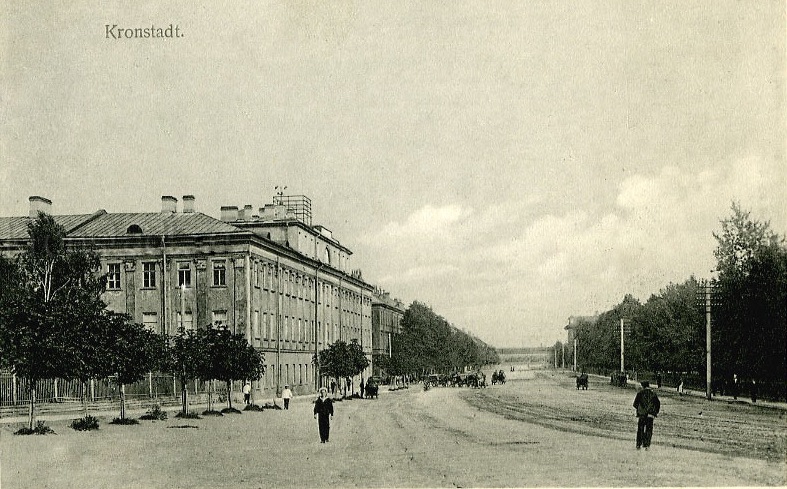
After watching the drill for a while, I was taken on to the Kronstadt Naval Club—a place hardly Nami cm. sufficiently explained by its name. Like everything of the nature of a public building in Russia, it is architecturally very fine. It is fitted with a theatre, museum, drawing-rooms, a large dining-hall, billiard, and the usual other sorts of rooms one finds in a club; practically it is the "officers' quarters," and nearly all unmarried officers stationed at Kronstadt live here.
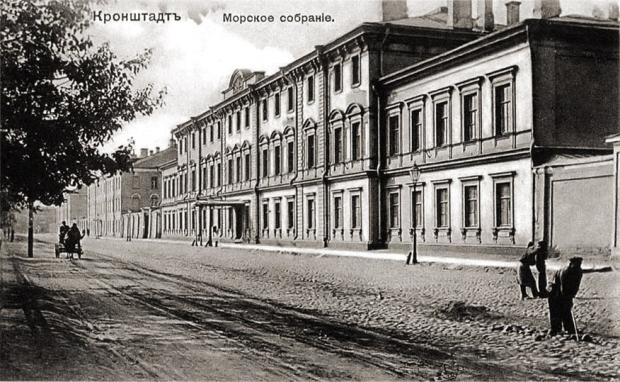
It is, so far as ornaments arc concerned, almost entirely furnished with gifts from the French nation on the French gifts: occasiou of thc Toulon aff"air, when the Franco-Russian alliance was cemented. One way and another these gifts to the Russian Navy from different French towns must be worth over half a million pounds ; there are numbers of huge solid silver figures of exclusive workmanship, a few of solid gold, while silk flags, jeweled ornaments, and valualjle china-ware are too numerous to be reckoned. There are rooms and rooms of them.
The museum is small, and of no special interest. What there is of it is chiefly geological, the balance mostly stuffed birds. There is, however, an interesting collection of harpooning instruments, chronologically arranged ; and there are a few models of ships of very early type. This place, however, is in no way on a par with the museum of our United Service Institution, which the Navy Club resembles much more than it does an ordinary club.
A word might bу said of the pictures. There is no pictures gallery, but the walls generally are hung with large paintings that form a very complete history of the Russian Navy from the time of Peter the Great onward and a high level of technical accuracy being maintained, these are useful as well as ornamental. The finest of these is one of the French fleet at Kronstadt — a masterpiece of bold artistic treatment. Another favourite wall-ornament is weapons. These, lethal and firearms, are arranged chronologically in devices on the walls of the vestibule and staircase.
Did space permit, one could spin out a good deal about the Naval Club at Kronstadt ; but perhaps
enough has been said.
Town.
With regard to the town itself, the streets are extremely wide, but most of the buildings are of
wood. A few buildings, like the Navy Staff, are of stone. At the Navy Staff", the hall is hung with half sectional models of all early Russian ships, but there being nothing- of much later date than the Peter Veliky one's interest in these was naturally curtailed.
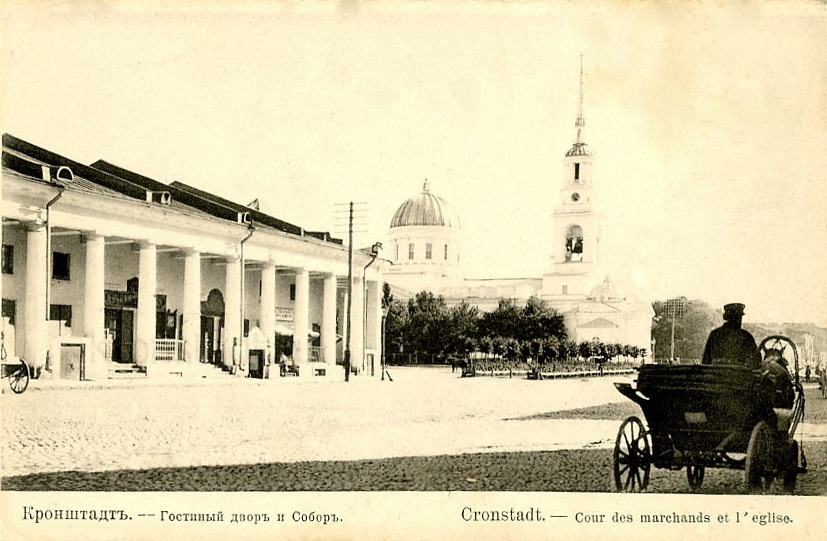
Of the famous Kronstadt forts I saw nothing at Forts. all ; no signs of them were visible anywhere,—probably the snow concealed them ; the appended sketch map indicates their positions, and shows pretty clearly that the place is as impregnable as can well be ; while the outlying Fort Constantine practically precludes anything in the way of a long-range bombardment. No great study of this map is required to show why Admiral Napier did not attack the place in the Crimean War ; nothing save specially constructed monitors would have a chance against it.
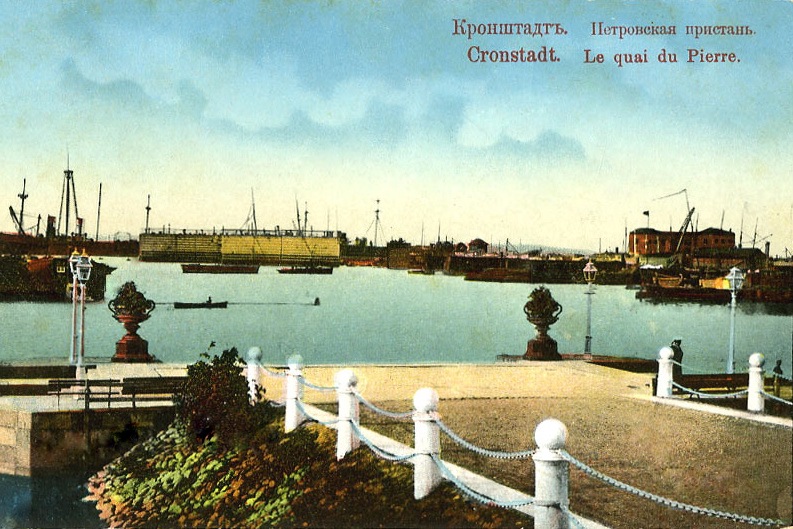
Kronstadt being a commercial port as well as a naval arsenal, there is an English colony there, and this, combined with the floating population of the merchant ships, leads to an English chaplain being permanently stationed at the place. In connection with the English in Russia, it maybe of some interest to mention that at Kronstadt I found Russian officers with English wives, a third whose mother was an Englishwoman, while a daughter of the Admiral commanding is married to a British naval officer; but there no loonier remain any English servinig- as officers in the Russian Navy as in the old days.
Half the Russian officers connected with the early days of Kronstadt were, of course. Englishmen ; and the Russians do not forget what nation it was that taught them to be sailors. There is at present, as I have already observed, a great craze for everything about Russian ships to be made in Russia ; but, as we know, a good many Russian vessels are just now being built or
ordered in France, Germany, and the United States. Yet it is only owing- to the recent engineering- strike that most of these ships are not building in England. Whether owing to this country's help in the early days when the Russian Navy was growing or whether as the result of experience, Russians have a heavy preference for English over other foreign ship material.
Their description of the British workman, however, is " A person who always refuses to work when his employer has undertaken to deliver a job in a certain time! ".
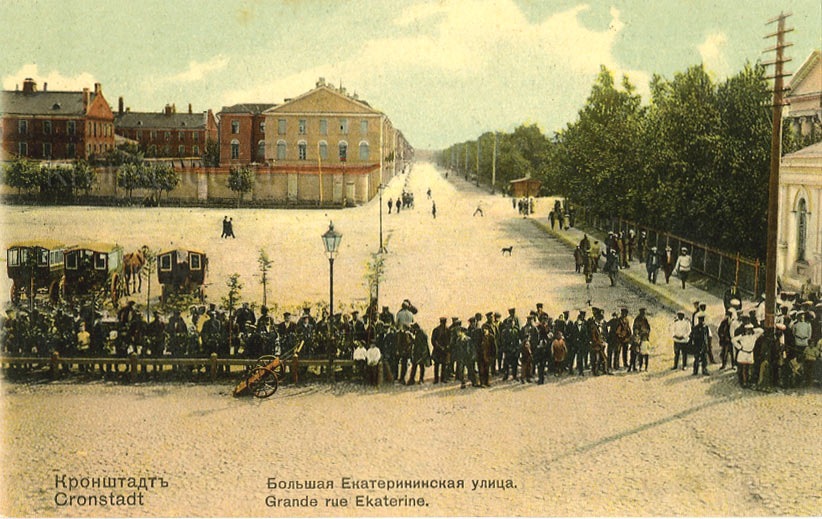
A bit sweeping and severe, maybe, yet perhaps not altogether without some sraius of truth. There is not the slightest shadow of doubt but that the British mechanic has only himself to thank in that he is not working on the Tsarvitch, Bayan, Waryag, RetAnsan, and the rest ; the Russian officials would sooner far have had these ships built in England than at La Seyne and C'ramp's. No question of cost entered : the Russian has not yet learnt to appreciate the cheap and nasty ; indeed, so particular are the Russians in the contract specifications, that it is the invariable rule everywhere to charge them more than any other nation.
The theory that an anti-British feeling had anything to do with next to no work being sent to British firms is absolutely without foundation. This is not a mere expression of opinion on my part, but a statement resting- on the first authority.






